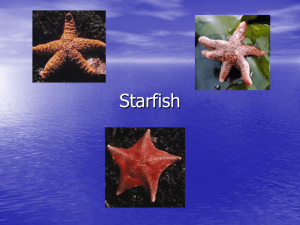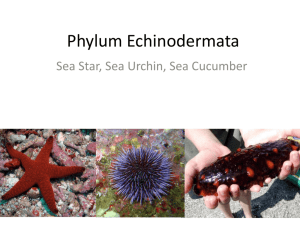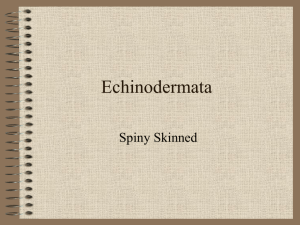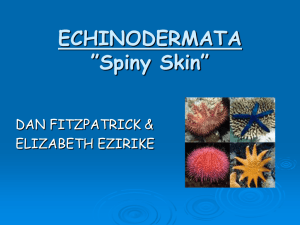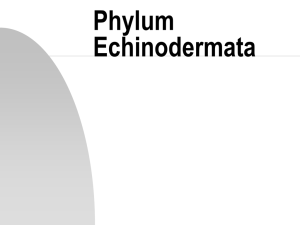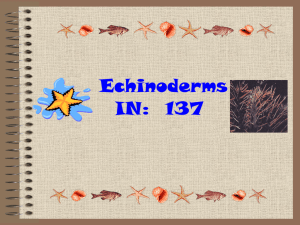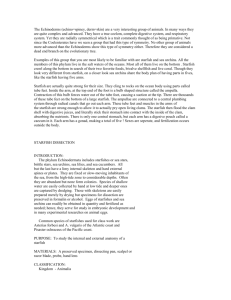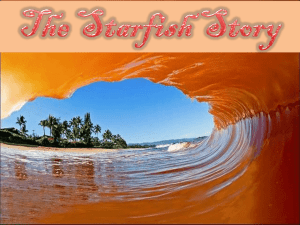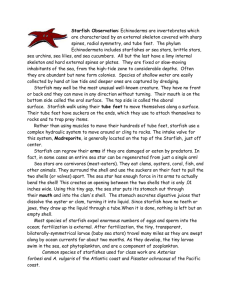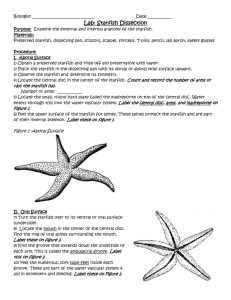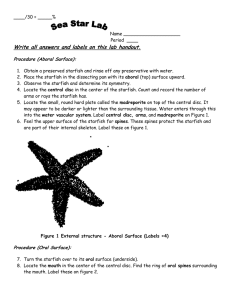Echinoderm lab 5-3-12
advertisement
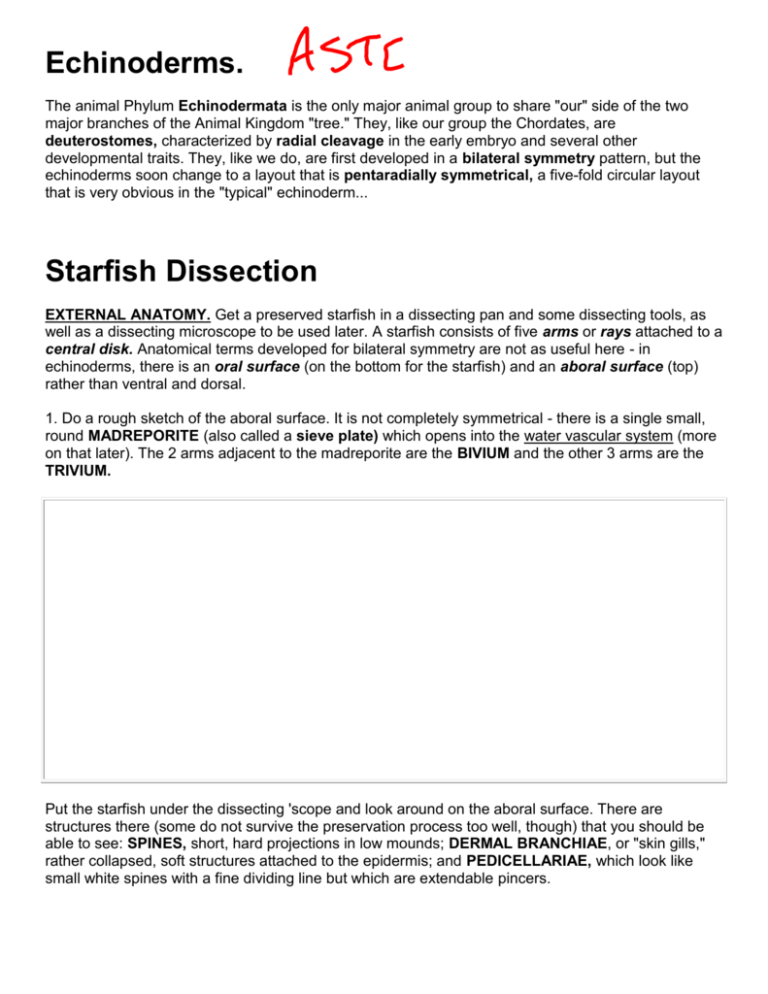
Echinoderms. The animal Phylum Echinodermata is the only major animal group to share "our" side of the two major branches of the Animal Kingdom "tree." They, like our group the Chordates, are deuterostomes, characterized by radial cleavage in the early embryo and several other developmental traits. They, like we do, are first developed in a bilateral symmetry pattern, but the echinoderms soon change to a layout that is pentaradially symmetrical, a five-fold circular layout that is very obvious in the "typical" echinoderm... Starfish Dissection EXTERNAL ANATOMY. Get a preserved starfish in a dissecting pan and some dissecting tools, as well as a dissecting microscope to be used later. A starfish consists of five arms or rays attached to a central disk. Anatomical terms developed for bilateral symmetry are not as useful here - in echinoderms, there is an oral surface (on the bottom for the starfish) and an aboral surface (top) rather than ventral and dorsal. 1. Do a rough sketch of the aboral surface. It is not completely symmetrical - there is a single small, round MADREPORITE (also called a sieve plate) which opens into the water vascular system (more on that later). The 2 arms adjacent to the madreporite are the BIVIUM and the other 3 arms are the TRIVIUM. Put the starfish under the dissecting 'scope and look around on the aboral surface. There are structures there (some do not survive the preservation process too well, though) that you should be able to see: SPINES, short, hard projections in low mounds; DERMAL BRANCHIAE, or "skin gills," rather collapsed, soft structures attached to the epidermis; and PEDICELLARIAE, which look like small white spines with a fine dividing line but which are extendable pincers. 2. Draw the area around a spine, including the structures mentioned above, and label them. Turn the starfish over and look at its oral surface, both without and with the dissecting 'scope. Each arm has a medial ambulacral groove. In each groove are the suckered tips of tube feet, driven mostly by the hydraulic power of the water vascular system fine-tuned with muscles. The oral central disk area is the peristome. 3. Describe the tube feet. You may want to manipulate them a bit. 4. Describe the peristome, including the types of tube feet there. STARFISH INTERNAL ANATOMY. You are going to dissect one of the trivium arms and the central disk. First, use scissors to remove the aboral half of the arm, taking care to cut and remove no more than the integument (look at the thin epidermis with flexible netlike skeletal elements - a question will relate to it in Part Two). Compare to the cutaway view on the reference sheet. Note what you can see of the coelomic space; its peritoneal membrane is lined with cilia which circulate nutrients and respiratory gases throughout the animal efficiently enough that no one is sure just what purpose is served by the small network of blood vessels (not visible) also found in the animals. Cut around the aboral surface of the central disk where it meets the arms, but cut around the inside of the madreporite. To remove the integument, you'll probably have to cut through the rectal attachment to the anus, a small pore in the middle. Starfish feeding commonly involves actually extruding the stomach out the mouth into prey animals such as clams, barnacles, and snails, and secreting digestive enzymes into the prey. A soup of broken-down materials is then taken into the intestine. The digestive enzymes come from digestive glands located aborally in the arms. 5. Describe the digestive glands. 6. The gonads lie beneath the digestive glands and somewhat more proximal to the central disk. Describe them. The single most unique feature of Echinoderms is their water vascular system. It is made up a a network of hard distribution tubes that deliver water under pressure to the tube feet and pedicellaria to extend and retract them and power the suckers and pincers, respectively. Take out the soft internal organs and inspect the calcified tubes of the system: the MADREPORITE connects by a vertical STONE CANAL to a RING CANAL that runs around the oral side of the central disk. From the ring canal radiate RADIAL CANALS out each arm along the ambulacral grooves, where small LATERAL CANALS connect to bulb-like structures, AMPULLAE, at the bases of the tube feet. Small muscles in the tube feet steer them while extending and flatten the sucker-ends on contact. 7. Draw and label the water vascular system of the central disk and one arm - all of the structures in bold capitals above should appear as labels.
